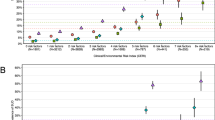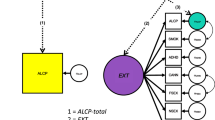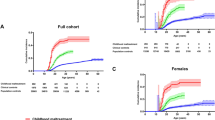Abstract
The global burden of disease attributable to externalizing disorders such as alcohol misuse calls urgently for effective prevention and intervention. As our current knowledge is mainly derived from high-income countries such in Europe and North-America, it is difficult to address the wider socio-cultural, psychosocial context, and genetic factors in which risk and resilience are embedded in low- and medium-income countries. c-VEDA was established as the first and largest India-based multi-site cohort investigating the vulnerabilities for the development of externalizing disorders, addictions, and other mental health problems. Using a harmonised data collection plan coordinated with multiple cohorts in China, USA, and Europe, baseline data were collected from seven study sites between November 2016 and May 2019. Nine thousand and ten participants between the ages of 6 and 23 were assessed during this time, amongst which 1278 participants underwent more intensive assessments including MRI scans. Both waves of follow-ups have started according to the accelerated cohort structure with planned missingness design. Here, we present descriptive statistics on several key domains of assessments, and the full baseline dataset will be made accessible for researchers outside the consortium in September 2019. More details can be found on our website [cveda.org].
This is a preview of subscription content, access via your institution
Access options
Subscribe to this journal
Receive 12 print issues and online access
$259.00 per year
only $21.58 per issue
Buy this article
- Purchase on Springer Link
- Instant access to full article PDF
Prices may be subject to local taxes which are calculated during checkout


Similar content being viewed by others
References
Bogdan R, Salmeron BJ, Carey CE, Agrawal A, Calhoun VD, Garavan H, et al. Imaging genetics and genomics in psychiatry: a critical review of progress and potential. Biol Psychiatry. 2017;82:165–75.
Pine DS, Ernst M, Leibenluft E. Imaging–genetics applications in child psychiatry. J Am Acad Child Adolesc Psychiatry. 2010;49:772–82.
Viding E, Williamson DE, Hariri AR. Developmental imaging genetics: challenges and promises for translational research. Dev Psychopathol. 2006;18:877–92.
Meyer-Lindenberg A. Imaging genetics of schizophrenia. Dialogues Clin Neurosci. 2010;12:449.
Scharinger C, Rabl U, Sitte HH, Pezawas L. Imaging genetics of mood disorders. Neuroimage. 2010;53:810–21.
Durston S. Imaging genetics in ADHD. Neuroimage. 2010;53:832–8.
Domschke K, Dannlowski U. Imaging genetics of anxiety disorders. Neuroimage. 2010;53:822–31.
Bigos KL, Weinberger DR. Imaging genetics—days of future past. Neuroimage. 2010;53:804–9.
Schumann G, Benegal V, Yu C, Tao S, Jernigan T, Heinz A, et al. Precision medicine and global mental health. Lancet Glob Health. 2019;7:e32.
Thompson PM, Stein JL, Medland SE, Hibar DP, Vasquez AA, Renteria ME, et al. The ENIGMA Consortium: large-scale collaborative analyses of neuroimaging and genetic data. Brain Imaging Behav. 2014;8:153–82.
Griswold MG, Fullman N, Hawley C, Arian N, Zimsen SR, Tymeson HD, et al. Alcohol use and burden for 195 countries and territories, 1990–2016: a systematic analysis for the Global Burden of Disease Study 2016. Lancet. 2018;392:1015–35.
Manthey J, Shield KD, Rylett M, Hasan OS, Probst C, Rehm J. Global alcohol exposure between 1990 and 2017 and forecasts until 2030: a modelling study. The Lancet. 2019;393:2493–502.
World Health Organization. Global status report on alcohol and health. Geneva: World Health Organization Violence Against Women: Intimate partner and sexual; 2011.
Quinlan EB, Cattrell A, Jia T, Artiges E, Banaschewski T, Barker G, et al. Psychosocial stress and brain function in adolescent psychopathology. Am J Psychiatry. 2017;174:785–94.
Barch DM, Belden AC, Tillman R, Whalen D, Luby JL. Early childhood adverse experiences, inferior frontal gyrus connectivity, and the trajectory of externalizing psychopathology. J Am Acad Child Adolesc Psychiatry. 2018;57:183–90.
Stacey D, Bilbao A, Maroteaux M, Jia T, Easton AC, Longueville S, et al. RASGRF2 regulates alcohol-induced reinforcement by influencing mesolimbic dopamine neuron activity and dopamine release. Proc Natl Acad Sci USA. 2012;109:21128–33.
Schumann G, Coin LJ, Lourdusamy A, Charoen P, Berger KH, Stacey D, et al. Genome-wide association and genetic functional studies identify autism susceptibility candidate 2 gene (AUTS2) in the regulation of alcohol consumption. Proc Natl Acad Sci USA. 2011;108:7119–24.
Dong L, Bilbao A, Laucht M, Henriksson R, Yakovleva T, Ridinger M, et al. Effects of the circadian rhythm gene period 1 (per1) on psychosocial stress-induced alcohol drinking. Am J Psychiatry. 2011;168:1090–8.
Clarke T-K, Laucht M, Ridinger M, Wodarz N, Rietschel M, Maier W, et al. KCNJ6 is associated with adult alcohol dependence and involved in gene× early life stress interactions in adolescent alcohol drinking. Neuropsychopharmacology.2011;36:1142.
Blomeyer D, Treutlein J, Esser G, Schmidt MH, Schumann G, Laucht M. Interaction between CRHR1 gene and stressful life events predicts adolescent heavy alcohol use. Biol Psychiatry. 2008;63:146–51.
Venkata JA, Panicker AS. Prevalence of attention deficit hyperactivity disorder in primary school children. Indian J Psychiatry. 2013;55:338.
Pathak R, Sharma RC, Parvan UC, Gupta BP, Ojha RK, Goel N. Behavioural and emotional problems in school going adolescents. Australas Med J. 2011;4:15–21.
Benegal V, Nayak M, Murthy P, Chandra P, Gururaj G, Obot I. Women and alcohol use in India. In: Alcohol, gender and drinking problems: perspectives from low and middle income countries. World Health Organisation, Geneva. 2005;89:123.
Charlson FJ, Baxter AJ, Cheng HG, Shidhaye R, Whiteford HA. The burden of mental, neurological, and substance use disorders in China and India: a systematic analysis of community representative epidemiological studies. Lancet. 2016;388:376–89.
Khandelwal S, Reddy K. Eliciting a policy response for the rising epidemic of overweight‐obesity in India. Obes Rev. 2013;14:114–25.
Varadharajan KS, Thomas T, Kurpad AV. Poverty and the state of nutrition in India. Asia Pac J Clin Nutr. 2013;22:326–39.
Jedrychowski WA, Perera FP, Majewska R, Camman D, Spengler JD, Mroz E, et al. Separate and joint effects of tranplacental and postnatal inhalatory exposure to polycyclic aromatic hydrocarbons: prospective birth cohort study on wheezing events. Pediatr Pulmonol. 2014;49:162–72.
McCrone P, Craig TK, Power P, Garety PA. Cost-effectiveness of an early intervention service for people with psychosis. Br J Psychiatry. 2010;196:377–82.
Schumann G, Loth E, Banaschewski T, Barbot A, Barker G, Buchel C, et al. The IMAGEN study: reinforcement-related behaviour in normal brain function and psychopathology. Mol Psychiatry. 2010;15:1128–39.
Toledano MB, Mutz J, Röösli M, Thomas MS, Dumontheil I, Elliott P. Cohort profile: the study of cognition, adolescents and mobile phones (SCAMP). Int J Epidemiol. 2018;48:25–6l.
Boyd A, Golding J, Macleod J, Lawlor DA, Fraser A, Henderson J, et al. Cohort profile: the ‘children of the 90s’—the index offspring of the Avon Longitudinal Study of Parents and Children. Int J Epidemiol. 2013;42:111–27.
Duncan SC, Duncan TE, Hops H. Analysis of longitudinal data within accelerated longitudinal designs. Psycholog Methods 1996;1:236–48.
Little TD, Rhemtulla M. Planned missing data designs for developmental researchers. Child Dev Perspect. 2013;7:199–204.
World Medical Association. World Medical Association Declaration of Helsinki. Ethical principles for medical research involving human subjects. Bulletin of the World Health Organization. 2001;79:373.
Houtepen LC, Heron J, Suderman MJ, Tilling K, Howe LD. Adverse childhood experiences in the children of the Avon Longitudinal Study of Parents and Children (ALSPAC). Wellcome Open Res. 2018;3:106–20.
Clark DB, Fisher CB, Bookheimer S, Brown SA, Evans JH, Hopfer C, Hudziak J, Montoya I, Murray M, Pfefferbaum A, Yurgelun-Todd D. Biomedical ethics and clinical oversight in multisite observational neuroimaging studies with children and adolescents: the ABCD experience. Developmental Cogn Neurosci. 2018;32:143–54.
Seaman SR, Bartlett JW, White IR. Multiple imputation of missing covariates with non-linear effects and interactions: an evaluation of statistical methods. BMC Med Res Methodol. 2012;12:46.
Seaman SR, White IR, Copas AJ, Li L. Combining multiple imputation and inverse-probability weighting. Biometrics. 2012;68:129–37.
Mills KL, Tamnes CK. Methods and considerations for longitudinal structural brain imaging analysis across development. Dev Cogn Neurosci. 2014;9:172–90.
Falk EB, Hyde LW, Mitchell C, Faul J, Gonzalez R, Heitzeg MM, et al. What is a representative brain? Neuroscience meets population science. Proc Natl Acad Sci USA. 2013;110:17615–22.
Matta TH, Flournoy JC, Byrne ML. Making an unknown unknown a known unknown: missing data in longitudinal neuroimaging studies. Dev Cogn Neurosci. 2018;33:83–98.
Reich D, Thangaraj K, Patterson N, Price AL, Singh L. Reconstructing Indian population history. Nature. 2009;461:489.
Thyreau B, Schwartz Y, Thirion B, Frouin V, Loth E, Vollstadt-Klein S, et al. Very large fMRI study using the IMAGEN database: sensitivity-specificity and population effect modeling in relation to the underlying anatomy. NeuroImage. 2012;61:295–303.
Funding
c-VEDA is jointly funded by the Indian Council for Medical Research (ICMR/MRC/3/M/2015-NCD-I) and the Newton Grant from the Medical Research Council (MR/N000390/1), United Kingdom.
The c-VEDA consortium
Vivek Benegal29, Gunter Schumann30, Pratima Murthy31, Bharath Holla31, Eesha Sharma32, Meera Purushottam33, Rose Dawn Bharath34, Sanjeev Jain31, Mathew Varghese31, Thennarasu Kandavel35, Deepak Jayarajan31, Keshav Kumar36, Preeti Jacob32, Amit Chakrabarti37, Rajkumar Lenin Singh38, Roshan Lourembam Singh38, Debasish Basu39, Subodh Bhagyalakshmi Nanjayya39, Chirag Kumar Ahuja40, Kartik Kalyanram41, Kamakshi Kartik41, Kumaran Kalyanram42, Krishnaveni Ghattu42, Murali Krishna43, Rebecca Kuriyan44, Sunita Simon Kurpad45, Sylvane Desrivieres30, Gareth Barker46, Udita Iyengar30, Yuning Zhang30, Nilakshi Vaidya30, Matthew Hickman47, Jon Heron48, Gwen Fernandes49, Mireille Toledano50, Dimitri Papadopoulos Orfanos51, Madhavi Rangaswamy52, Gitanjali Narayanan53, Urvakhsh Meherwan Mehta31, Paul Elliott50, Satish Chandra Girimaji32, Madhu Khullar54, Niranjan Khandelwal55, Nainesh Joshi54, Amit55, Debangana Bhattacharya56, Bidisha Haque56, Arpita Ghosh56, Alisha Nagraj56, Anirban Basu56, Mriganka Mouli Pandit56, Subhadip Das56, Anupa Yadav56, Surajit Das56, Sanjit Roy56, Pawan Kumar Maurya56, Ningthoujam Debala Chanu38, Fujica M C38, Victoria Ph.38, Celina Phurailatpam38, Amritha Gourisankar41, Geetha Rani41, Sujatha B41, Caroline Fall57, Kiran K N42, Ramya M C42, Chaithra Urs42, Santhosh N42, Somashekhara R42, Divyashree K42, Arathi Rao44, Poornima R44, Saswathika Tripathy29, Neha Parashar29, Dhanalakshmi D29, Nayana K B29, Ashwini Kalkunte Seshadri29, Sathish Kumar29, Thamodaran Arumugam29, Apoorva Safai29, Suneela Kuman Baligar29, Anthony Mary Cyril29, Aanchal Sharda29, Rashmitha29, Ashika Anne Roy29, Shivamma D29, Kiran L29, Bhavana B R29
Author information
Authors and Affiliations
Consortia
Corresponding authors
Ethics declarations
Conflict of interest
The authors declare that they have no conflict of interest.
Additional information
Publisher’s note Springer Nature remains neutral with regard to jurisdictional claims in published maps and institutional affiliations.
Supplementary information
Rights and permissions
About this article
Cite this article
Zhang, Y., Vaidya, N., Iyengar, U. et al. The Consortium on Vulnerability to Externalizing Disorders and Addictions (c-VEDA): an accelerated longitudinal cohort of children and adolescents in India. Mol Psychiatry 25, 1618–1630 (2020). https://doi.org/10.1038/s41380-020-0656-1
Received:
Revised:
Accepted:
Published:
Issue Date:
DOI: https://doi.org/10.1038/s41380-020-0656-1
This article is cited by
-
Environmental neuroscience linking exposome to brain structure and function underlying cognition and behavior
Molecular Psychiatry (2023)
-
Federated Analysis in COINSTAC Reveals Functional Network Connectivity and Spectral Links to Smoking and Alcohol Consumption in Nearly 2,000 Adolescent Brains
Neuroinformatics (2023)
-
Adverse childhood experiences and substance misuse in young people in India: results from the multisite cVEDA cohort
BMC Public Health (2021)
-
Decentralized Multisite VBM Analysis During Adolescence Shows Structural Changes Linked to Age, Body Mass Index, and Smoking: a COINSTAC Analysis
Neuroinformatics (2021)
-
Molecular Psychiatry, August 2020: new impact factor, and highlights of recent advances in psychiatry, including an overview of the brain’s response to stress during infection with the severe acute respiratory syndrome coronavirus 2 (SARS-CoV-2)
Molecular Psychiatry (2020)



